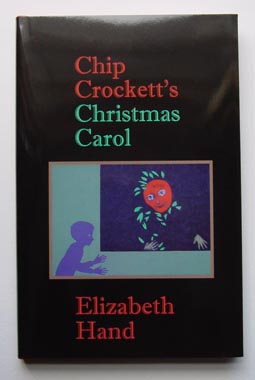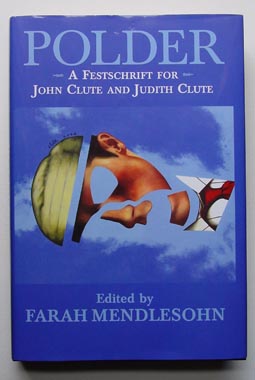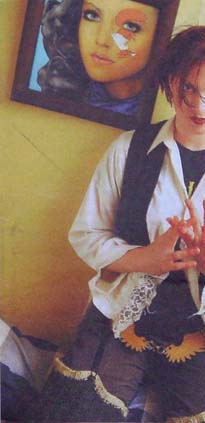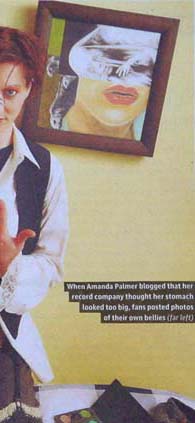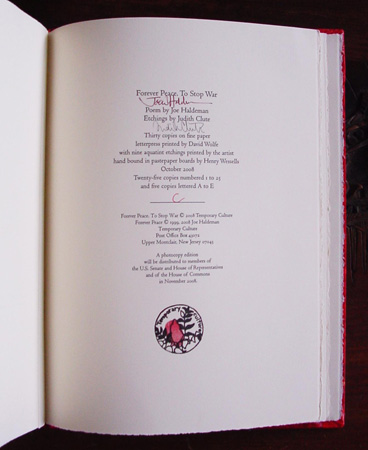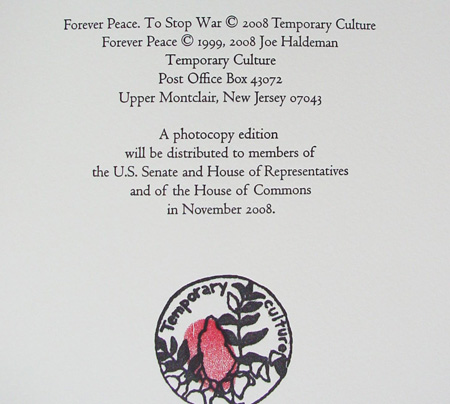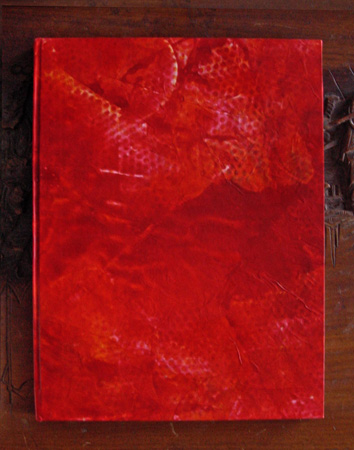PETER EDGERTON WILSONArtist, art critic, Sixties radical, mentor Wilson was eventually caught, his dictionaries confiscated. This naturally cemented a lifelong interest in China. But the prank also foreshadowed the life to come, the career in solitary pursuit of knowledge, the superb gift for drawing, the facility with language, and the irreverence. In the late sixties, when he returned to Canada from his studies in Chicago, Wilson became active on the left in the nationalist movement then sweeping Canada. He joined the Canadian Liberation Movement in Toronto, working on the movement’s newspaper New Canada and acting as a key adviser to Barry Lord during the writing of The History of Painting in Canada: Toward a People’s Art. At the same time, Wilson was freelancing as an art critic and illustrator, writing the art column at the Toronto Star. Artists were on the move in the early seventies, banding together to set up video co-ops, artist-run galleries, magazine collectives, and unions. Wilson soon became involved with the organizing effort behind Canadian Artists Representation, working alongside people such as John Boyle, Joyce Wieland, and Charlie Pachter. He was an astute political analyst and rhetorical genius who could sum up complex issues in simple sentences. “Most people work in order to make a living, but artists make a living in order to work,” he once remarked, which pretty much explains the economics of art-making. Peter Wilson was an eclectic intellectual; a politico who read Suetonius as well as Marx; an artist with no illusions about the art world; a virtuoso draughtsman (as adept at silverpoint as numismatics) who could grind his own colours. He studied at the École de Beaux Arts in Montréal and the Art Institute in Chicago, but his major break came when he and Judith Clute apprenticed with two European painters, Françoise André and Charles Stegeman, who came to Canada after the Second World War and taught at the Banff School of Fine Arts. This was when Wilson decided on a life in art. Judith remembers watching him doing riffs on Francis Bacon’s screaming Pope, drawing like da Vinci and then like Ingres; it was all elegance and energy in wild balance. Through the seventies and eighties, Wilson continued to paint, although he rarely exhibited. He and Susan Crean lived for a decade in the Junction, and then he moved to Karen Montesanto’s on McCaul Street, a stone’s throw from King Lee apartments where it all began in the sixties with a moveable feast of artists and travellers. He spent time with Vancouver sculptor Bob Foley, striking coins the old way — with die and mallet — crafting exquisite portraits of friends. He was a great friend to younger artists; some, like Texas writer/photographer Mary Lou Pilkington, visited regularly for decades. In later years, Peter would occasionally remark to close friends that he figured his life’s contribution would not be anything he himself created but rather the people he “created” — by which he meant the artists he helped launch. This was Peter’s special gift. He could recognize talent, often before anyone else did, and he knew how to encourage the artist in others. In the end, a powerful legacy. Artists Judith Clute and Karen Montesanto and writer Susan Crean are friends of Peter Wilson. |
Biography — the 1990s and early 2000s
By the 1990s I was painting back at home. Pamela Zoline and John Lifton having moved to Colorado, their room became my studio. The solvents of oil painting were not now a problem. I did several paintings in The Footpads of Darwin series, the first of which has an up-side down monkey face. The women with their backs to us, one of which has a bird on her head, are standing on the red-faced monkey: we are all, in some sense, footpads, an old English term for “thieves”.
As I write in 2002 I can see my painting life in the throes of the same old passions. Two series begun in the 1990s, Footpads of Darwin and Progress of Anansi, are still alive for me and I’m working further with the iconography of the letter “a” and recurring images of elephants and masks. And I’m still turning motifs upside down. Also I enjoyed my visit as Guest Artist at 2001, A Celebration of British SF, in Liverpool. And I’ve had pleasure working on two books which have come out in this year, 2002:
Paper Tiger Fantasy Art Gallery, edited by
Paul Barnett
http://www.papertiger.co.uk/ezine/fantasy_gallery/index.html
Fantasy Art Masters, Harper Collins, edited
by Dick Jude
http://www.collins.co.uk
We’ve set in a new category: Grab Bag. There are lots of drawings and sketches not on display. And linocuts. If you are curious and want to see more, a meeting can be arranged: as always e-mail me. Also there are strange things like the joke drawings done by Joe Haldeman and me. Included here is a photo of us on an Underground train in London doing these crazy drawings, passing the sketch book back and forth, adding shapes until nothing more could be added. In this fashion we filled a sketch book from Heathrow to Camden Town. Gay Haldeman took the photo.
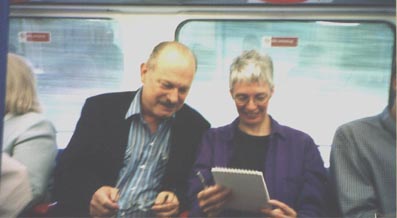
In the early part of the summer 2003 John Clute assembled some of his reviews to be published as Scores: reviews 1993-2003 for which I did the cover. See Covers. My photo shows him hard at work on the project at our kitchen table.
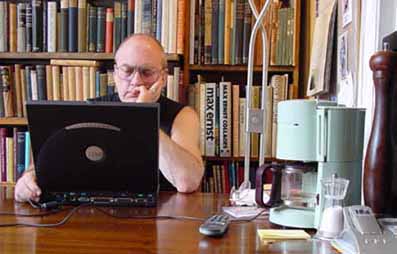
To make etchings is my new passion. Alongside painting of course. After a gap of twenty years, I needed to learn the craft again, or perhaps from a different perspective. I joined Artichoke Print Workshop and I’m working out strategies to get the varied effects I managed by luck in the early 1980s. It’s an apprenticeship with the good people at Artichoke: Megan Fishpool, Melvyn Petterson and Colin Gale.
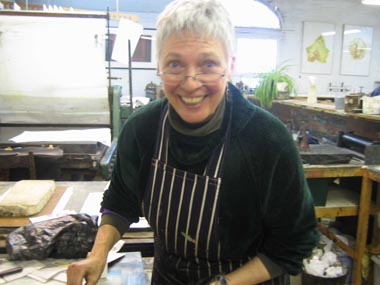
Judith at Artichoke
April
2006 update
Two special books have just been published. The first,
Polder, A Festscrift for John Clute and Judith Clute, is edited
by Farah Mendlesohn, published by Old
Earth Books, Baltimore. The book design is by Robert T. Garcia
and he has made use of my painting, Zeus
Weather, for the cover. This
painting
is from the collection of Farah Mendlesohn. I’m completely stunned
by the book. I knew about it in the works, thinking that the project
was to commemorate our flat, 221 B Camden High Street, because a number
of writers have made use of the place over the years, and indeed some
very important works have been written here. Tom Disch wrote “Camp
Concentration” here in 1967. And Pamela Zoline wrote “The
Heat Death of the Universe” here around the same time. But the
substance of the contributions just amazes me. So many friends have
participated with love and affection. First, of course, Farah in her
introduction. Actually Tom Disch’s poem, “ Songs of the
Rooftop” leads in before the introduction and it makes me laugh
and cry at the same time. Then there are contributions by Damien Broderick,
Rob Latham, Sean McMullen, Candas Jane Dorsey, Joe Haldeman, Geoff Ryman,
Scott Bradfield, Paul Kincaid, Brian Aldiss, William Gibson, Bruce Sterling,
Ian Watson, Neil Gaiman, Javier Martinez, Andy Butler, Jack Womack,
Gary Wolfe, Mike Harrison, Edward James, Stan Robinson, Ellen Datlow,
Liz Hand, Graham Sleight, Roz Kaveney, and last, but not least, Pamela
Zoline. Again I say I’m – stunned. There is so much creative
beauty in this book. I look at a story like Sean McMullen’s, for
instance, and I know the point of departure. When he came to stay he
did indeed spend hours sorting out the tangle of cables coming for the
telephone and I don’t know what all. When he left, everything
was neatly labelled and ordered. Somehow, from all this, emerges a story
about Baron Clute. And then a little farther into the book there is
Joe Haldeman’s contribution. That one hits me right in the heart.
I’m so touched I can’t speak the words. I just want to hug
everyone who contributed. But I mustn’t go on in this venue. I’ll
be writing personal letters.
The other book is “Chip Crockett’s Christmas Carol”
by Elizabeth Hand. As Beccon Publications say in their publicity, it
is the “first separate publication of this novella”, and
is a hardcover edition limited to just 222 signed and numbered copies.
Each is signed by both Liz and me. It is illustrated with nine original
etchings which I designed to be reproduced same size. Also I did
the
cover painting specially for the book.
A book for the Christmas Season and beyond - Chip Crockett’s Christmas Carol (Beccon Publications, 2007) by Elizabeth Hand, illustrated with nine etchings by Judith Clute. Signed by author and artist, limited to 222 copies hardback in dust wrapper: £19 from Beccon Publications (US price varies with exchange rate.)
Images for Chip Crockett, a limited edition suite of the plates from this book, is also available. Each individually-pulled etching is printed on 300wt Somerset paper, 15" x 11", in a signed and numbered edition of 20. Numbers 1 to 9 of each etching are included in the portfolio. Only nine copies will be issued. The etchings are enclosed within boards and flaps. The boards are marbled with cloth ties. £500.
Images of the nine etchings appear in the etchings section.
March 2007 update
This time I’m re-organising my etchings into categories: Believing the Bones; Footpads of Darwin; Masques of the
Disappeared; Chip Crockett’s
Christmas Carol; and Forever Peace.
The latter is a series (a work in progress) of etchings on the
theme of Joe Haldeman’s poem Forever Peace. The publisher
of Temporary Culture, Henry Wessels, plans to do a special
limited edition (maybe 24) with hand-printed text and my original etchings
bound into a special binding of some sort of special cloth “for
subscribers and patrons of contemporary artist’s books” (Henry’s
words). Then perhaps there would be a couple hundred copies as an anti-war
pamphlet, printed offset with reproductions of the images (nice paper
but not art paper). The last line of the poem is – “To
stop war, make men gods”. The first lines in each of the previous
six verses play with these words. They shift the words in different
combinations. My etchings will respond in a visual way to the ideas
of the poem and each will contain a word or part sentence or part word
from those six staccato words.
June 2007 update
An exhibition has been organised for a number of my paintings and etchings in Finland
this summer. It’s a two person exhibition
with Timo Sälekivi. It will be in the Galleria
Becker in Jyväskylä which is a beautiful university town
in central Finland. It is famed for its range of schools, being called
the Athens of Finland. This show has been organised by the Artists
Society of Jyväskylä and also with monies from the Finnish Arts Council. Irma Hirsjärvi did all the work setting
this up so that it will coincide with Finncon 07.
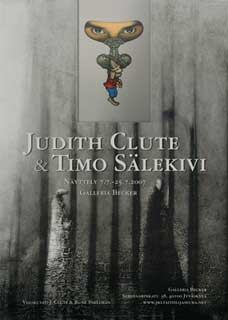
October 2007
update
The latest set of etchings, Forever Peace, is complete
November 2007 update:
There is a new painting in Works for Sale which has taken months to paint. It is called The Soldier’s Pole is Fall’n. This is from Shakespeare’s Antony and Cleopatra. Antony has just died in Cleopatra’s arms. She says:
The Crown o’the earth doth melt. My Lord!
O, withered is the garland of the war.
The Soldier’s pole is fall’n. Young boys and girls
are now level with men. The odds is gone,
and there is nothing left remarkable
Beneath the visiting moon.
I made the painting in memory of Peter Wilson, an old friend and lover, who died on November 7, 2006. As a very young man he had been an officer in the Canadian Army. When I first met him in the early 1960s he was still wearing his khaki shirts while studying to be an artist at the Banff School of Fine Arts in Alberta. I did a sketch of him then and I’ve used it for reference in this painting.
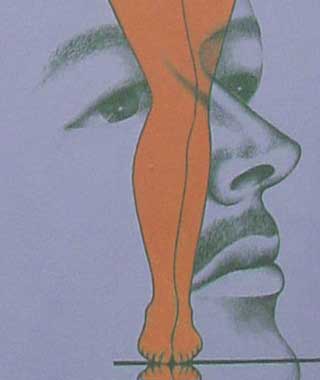
As I was working on the theme of artist and model, I think I captured something of his Celtic beauty. And John, who also knew him from the mid-1960s, helped me with the title.
Also Susan Crean who lived for many years with Peter wrote an excellent note called The Lives Lived about Peter for the Globe and Mail, May 24, 2007. In fact she had a little help from me and another close friend of Peter’s, artist Karen Montesanto. So the three of us were credited with the writing. But it was really Susan’s.
May 2008 update:
One completely new painting, a few reworked ones, (Footpads of Darwin: Jump for instance), and some etchings. And also I’ve had two little exhibitions – London School of Economics Art Show and Artichoke Printmaking at Clifford Chance.
As I sit at my computer here in the main room I look across at two paintings – Noah and The Doorman. I see that somehow through the years, since the 70s even, I’ve been pushing and pulling at disparate elements, trying to achieve a sort of poise, a moment of calm, on the canvas. I like some of the results. They breathe of the present moment. At least that’s they way I see them.
But also I’ve been doing close-up faces. They are quite different. There’s more a feeling of horror implicit in them. Right now there are two of this sort hanging on my studio wall, Valley Girl and Slippage. (Both recently reworked.) My latest painting, Canto, falls in with their ambience, but it has close-up heads that are more – shall we say – exposed. I’m fond of this one. I hope others will like it too.
Incidently, I’ve made a decision to no longer set in any dates on my paintings. Only a small signature. Likewise, no dates on my etchings. Of course dates will always be here in my site.
December 2008 update:
I’m so happy with the way Henry Wessells has produced his book: Forever Peace. To Stop War. His paste paper covers are stunning. And if I may say so it is very satisfying to see my actual editioned prints in situ. Here’s a pic of me looking very happy this summer
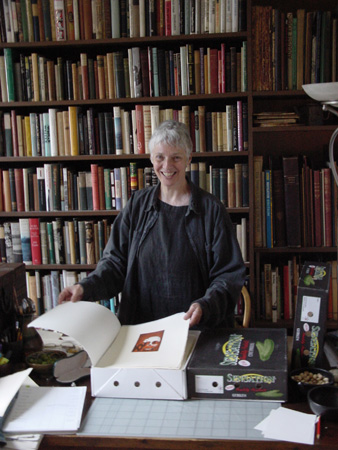
when I was handing over to Henry all the finished artwork (270 prints). Note the paper size fitted perfectly into boxes from the street market outside. Cucumber boxes even. And also a pic of Henry leaving with all that editioned work.
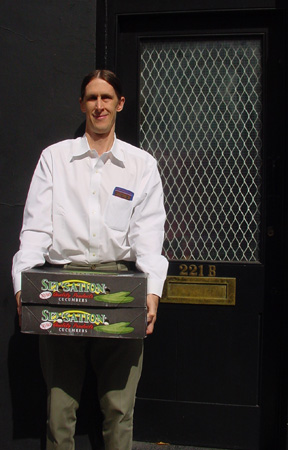
February 2009 update:
On the 6th of February this year (2009), the Guardian newspaper ran an article featuring two of my paintings, Valley Girl and Footpads of Darwin: Slippage, in an interesting context: Amanda Palmer of the cabaret punk group, Dresden Dolls, likes these paintings and wanted them framing her in the photo shoot. She had been here in London playing at the famous Electric Ballroom, across the road from me, to mark the beginning of a long European and Australian tour.
(Guardian photographer is Linda Nylind)
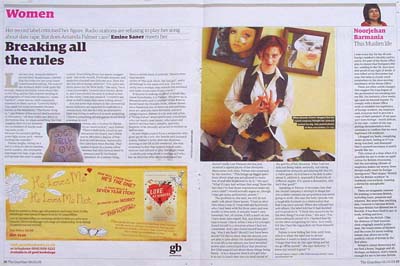
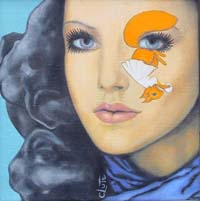 |
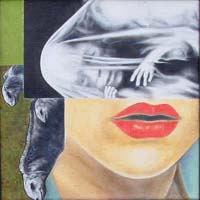 |

